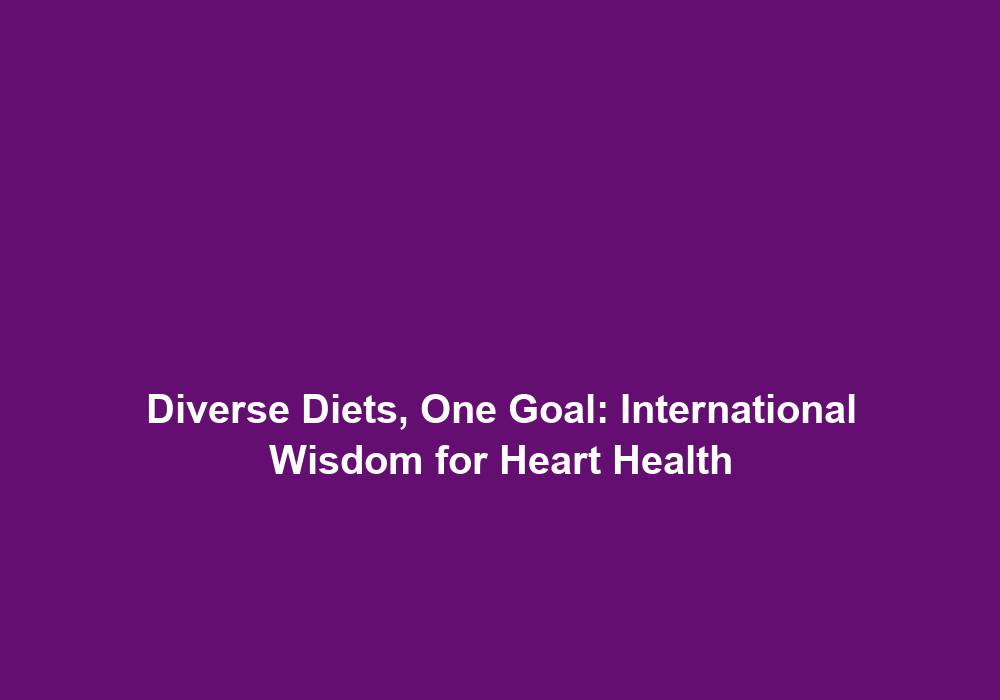Diverse Diets, One Goal: International Wisdom for Heart Health
Maintaining a healthy heart is crucial for overall well-being, and one way to achieve this is through a balanced and wholesome diet. While there are numerous dietary approaches and trends, it’s important to acknowledge that different cultures have their own unique culinary traditions that can contribute to heart health. In this article, we will explore various diverse diets from around the world, highlighting their key components and how they can play a role in promoting cardiovascular wellness.
The Mediterranean Diet: A Timeless Classic
One of the most renowned diets when it comes to heart health is the Mediterranean diet. This eating pattern originates from countries surrounding the Mediterranean Sea and is known for its emphasis on whole foods, healthy fats, and abundance of fruits and vegetables. The Mediterranean diet encourages the consumption of olive oil, legumes, nuts, seeds, whole grains, fish, and moderate amounts of dairy and poultry. Red meat is limited in this diet, making it an excellent choice for reducing the risk of heart disease.
The Mediterranean diet provides a wide range of health benefits that contribute to heart health. The consumption of olive oil, which is rich in monounsaturated fats, is a key component of this diet. Monounsaturated fats have been shown to reduce LDL cholesterol levels, also known as “bad” cholesterol, and lower the risk of heart disease. Additionally, the high intake of fruits and vegetables in this diet provides a rich source of antioxidants, vitamins, and minerals that are essential for cardiovascular health. The inclusion of fish, particularly fatty fish like salmon and sardines, provides omega-3 fatty acids, which have anti-inflammatory properties and can help lower blood pressure and reduce the risk of heart disease.
To incorporate the Mediterranean diet into your eating habits, consider the following tips:
-
Include a variety of fruits and vegetables: Aim to consume at least 5 servings of fruits and vegetables each day. Choose colorful options such as tomatoes, peppers, spinach, and berries, as they are packed with heart-healthy nutrients.
-
Use olive oil as your primary fat: Replace butter and margarine with olive oil for cooking and salad dressings. Olive oil is a healthier alternative that can improve cholesterol levels and reduce the risk of heart disease.
-
Include whole grains: Opt for whole grain options like whole wheat bread, brown rice, and quinoa instead of refined grains. Whole grains are high in fiber, which can help lower cholesterol levels and promote heart health.
-
Increase fish consumption: Aim to have fish at least twice a week, preferably fatty fish like salmon, mackerel, and trout. These fish are rich in omega-3 fatty acids, which have numerous heart-protective effects.
-
Limit processed and red meats: Reduce your intake of processed meats like sausages and deli meats, as they are high in unhealthy fats and sodium. Limit red meat consumption to a few times a month and opt for lean cuts.
The Japanese Diet: A Nutritional Powerhouse
Japan is known for its longevity and low rates of heart disease, and its traditional diet may be a key factor. The Japanese diet primarily consists of fresh and seasonal ingredients, with an emphasis on fish, seafood, tofu, vegetables, and fermented foods like miso and soy sauce. The consumption of rice, green tea, and seaweed is also prominent. These dietary choices are rich in omega-3 fatty acids, antioxidants, and minerals, all of which are beneficial for heart health.
The Japanese diet offers several components that contribute to heart health. Fish and seafood, which are staple foods in this diet, are excellent sources of omega-3 fatty acids. Omega-3 fatty acids have been shown to reduce inflammation, lower triglyceride levels, and decrease the risk of heart disease. The consumption of tofu and other soy products provides plant-based protein and is low in saturated fat, making it a heart-healthy alternative to animal-based proteins. Additionally, the inclusion of fermented foods like miso and soy sauce introduces probiotics into the diet, which support a healthy gut microbiome and have been linked to improved cardiovascular health.
To incorporate the Japanese diet into your eating habits, consider the following tips:
-
Include a variety of fish: Aim to have fish at least twice a week, preferably fatty fish like salmon, mackerel, and sardines. These fish are rich in omega-3 fatty acids, which have numerous heart-protective effects.
-
Incorporate soy products: Include tofu, tempeh, and edamame in your diet as plant-based protein sources. These products are low in saturated fat and provide essential nutrients for heart health.
-
Enjoy green tea: Swap sugary beverages with green tea, which is a popular drink in Japan. Green tea contains antioxidants called catechins, which have been shown to improve heart health.
-
Include seaweed in your meals: Try incorporating seaweed into your diet by using it as a salad ingredient, sushi wrap, or seasoning. Seaweed is a good source of minerals like iodine, which is important for thyroid function.
-
Opt for fermented foods: Include fermented foods like miso, soy sauce, and pickled vegetables in your meals. These foods introduce probiotics into your diet, which support a healthy gut microbiome and overall cardiovascular well-being.
The Nordic Diet: Embracing the Power of Nature
The Nordic diet, prevalent in Scandinavian countries, focuses on locally sourced, seasonal, and sustainable ingredients. This diet is centered around whole grains, berries, root vegetables, fish, and lean meats like reindeer and game. The Nordic diet promotes the use of rapeseed oil, which is high in heart-healthy monounsaturated fats. Additionally, this diet encourages the consumption of fermented foods like sauerkraut and pickled herring, which contribute to a healthy gut microbiome and overall cardiovascular well-being.
The Nordic diet offers several key components that support heart health. The emphasis on whole grains provides a good source of fiber, which can help lower cholesterol levels and reduce the risk of heart disease. Berries, particularly bilberries and lingonberries, are rich in antioxidants called anthocyanins, which have been shown to improve cardiovascular health by reducing inflammation and improving blood vessel function. The inclusion of fatty fish like salmon and trout provides omega-3 fatty acids, which have numerous heart-protective effects. Rapeseed oil, a common cooking oil in Nordic countries, is rich in monounsaturated fats and can help improve cholesterol levels.
To incorporate the Nordic diet into your eating habits, consider the following tips:
-
Choose whole grains: Opt for whole grain options like rye bread, barley, and oats instead of refined grains. Whole grains are rich in fiber and provide sustained energy throughout the day.
-
Include berries in your meals: Add a variety of berries like blueberries, lingonberries, and cloudberries to your meals and snacks. These berries are packed with antioxidants and can improve heart health.
-
Incorporate root vegetables: Include root vegetables like carrots, turnips, and potatoes in your meals. These vegetables are rich in fiber, vitamins, and minerals that support cardiovascular health.
-
Include fatty fish: Aim to have fatty fish like salmon, trout, and herring at least twice a week. These fish are a good source of omega-3 fatty acids, which have numerous heart-protective effects.
-
Use rapeseed oil in cooking: Replace unhealthy fats like butter and margarine with rapeseed oil for cooking and salad dressings. Rapeseed oil is high in monounsaturated fats, which can improve cholesterol levels and reduce the risk of heart disease.
-
Include fermented foods: Try incorporating fermented foods like sauerkraut, pickled herring, and fermented dairy products into your meals. These foods introduce probiotics into your diet, which support a healthy gut microbiome and overall cardiovascular well-being.
The Indian Diet: A Tapestry of Flavors and Health Benefits
India’s diverse culinary traditions offer a plethora of heart-healthy choices. The Indian diet is characterized by an array of colorful spices, legumes, whole grains, vegetables, and lean proteins like lentils and yogurt. Turmeric, an integral spice in Indian cuisine, contains an active compound called curcumin, which has anti-inflammatory properties and may help prevent heart disease. Furthermore, the use of ghee (clarified butter) in moderation provides essential fatty acids that are beneficial for heart health.
The Indian diet incorporates several components that contribute to heart health. Legumes, such as lentils, chickpeas, and kidney beans, are excellent sources of plant-based protein and fiber. These legumes can help lower cholesterol levels and reduce the risk of heart disease. Whole grains like brown rice, millet, and whole wheat provide a good source of fiber and nutrients that support heart health. The inclusion of a variety of colorful spices, such as turmeric, ginger, and garlic, adds flavor to dishes and provides health benefits. Turmeric, in particular, contains curcumin, which has been shown to have anti-inflammatory effects and may help prevent heart disease. The use of ghee, when consumed in moderation, provides essential fatty acids and can be a healthier alternative to regular butter.
To incorporate the Indian diet into your eating habits, consider the following tips:
-
Include a variety of legumes: Incorporate lentils, chickpeas, kidney beans, and other legumes into your meals. These legumes provide plant-based protein, fiber, and essential nutrients that support heart health.
-
Choose whole grains: Opt for whole grain options like brown rice, whole wheat bread, and millet. These whole grains are rich in fiber and provide sustained energy throughout the day.
-
Use a variety of spices: Experiment with a variety of spices like turmeric, ginger, garlic, and cumin in your cooking. These spices add flavor and provide health benefits, particularly turmeric with its anti-inflammatory properties.
-
Include a colorful variety of vegetables: Aim to have a colorful variety of vegetables in your meals. Include options like spinach, bell peppers, tomatoes, and carrots, as they are packed with heart-healthy nutrients.
-
Moderate use of ghee: Use ghee in moderation as a cooking fat or flavor enhancer. Ghee provides essential fatty acids and can be a healthier alternative to regular butter when consumed in moderation.
-
Include yogurt in your diet: Incorporate yogurt into your meals as a source of probiotics and calcium. Opt for plain yogurt without added sugars for maximum health benefits.
The Plant-Based Diet: Nourishing the Heart with Plants
A plant-based diet, as the name suggests, prioritizes plant foods such as fruits, vegetables, whole grains, legumes, nuts, and seeds while minimizing or excluding animal products. This diet is rich in fiber, antioxidants, and phytochemicals, all of which promote heart health. Studies have shown that a plant-based diet can reduce the risk of heart disease, lower blood pressure, and improve cholesterol levels. It also encourages the consumption of healthy fats like avocados and olive oil while limiting saturated and trans fats found in animal products.
A plant-based diet offers numerous benefits for heart health. The high intake of fruits and vegetables provides a wide range of vitamins, minerals, and antioxidants that support cardiovascular health. These plant foods are also low in calories and high in fiber, which can help maintain a healthy weight and reduce the risk of heart disease. Legumes, nuts, and seeds are excellent sources of plant-based protein, healthy fats, and fiber, which have been shown to improve cholesterol levels and lower the risk of heart disease. The inclusion of healthy fats like avocados and olive oil provides monounsaturated fats, which can improve cholesterol levels and reduce the risk of heart disease.
To incorporate a plant-based diet into your eating habits, consider the following tips:
-
Focus on whole, plant foods: Fill the majority of your plate with a variety of fruits, vegetables, whole grains, legumes, nuts, and seeds. These foods provide essential nutrients and fiber that promote heart health.
-
Include a variety of colors: Aim to have a colorful variety of fruits and vegetables in your meals. Different colors indicate different phytochemicals, which have unique health benefits.
-
Choose whole grains: Opt for whole grain options like quinoa, brown rice, whole-wheat bread, and oats. Whole grains are rich in fiber, which can help lower cholesterol levels and reduce the risk of heart disease.
-
Include a variety of legumes, nuts, and seeds: Incorporate a variety of legumes, nuts, and seeds into your meals and snacks. These foods provide plant-based protein, healthy fats, and fiber that support heart health.
-
Use healthy fats: Incorporate heart-healthy fats into your diet, such as avocados, olive oil, nuts, and seeds. These fats are beneficial for cardiovascular health when consumed in moderation.
-
Limit processed and sugary foods: Minimize your intake of processed and sugary foods, as they are often high in unhealthy fats, added sugars, and sodium. Opt for whole, natural foods whenever possible.
Incorporating International Wisdom into Your Diet
Now that we’ve explored various heart-healthy diets from around the globe, you may be wondering how to incorporate these principles into your own eating habits. Here are some practical tips:
-
Embrace whole, natural foods: Regardless of the specific diet you choose, focusing on whole foods is key. Avoid processed and packaged foods that are often high in unhealthy fats, sodium, and added sugars.
-
Prioritize fruits and vegetables: Aim to fill half your plate







